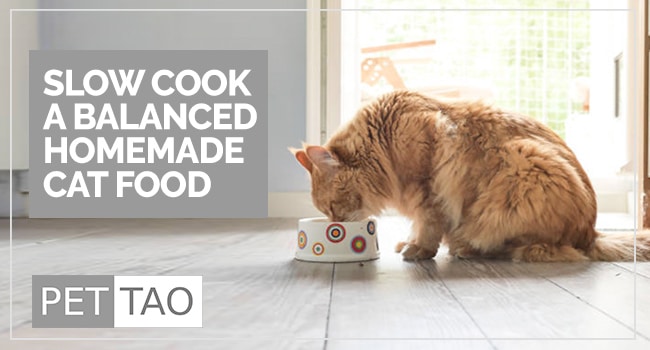Looking for a Good Cat Food Recipe?
If I told you feeding your cat a certain way could improve your cat’s health, longevity, and quality of life, would you believe me?
“All disease begins in the Gut.” – Hippocrates
What does Hippocrates mean?
Scientific evidence indicates many chronic metabolic diseases begin in the gut.
Poor nutrition and careless food choices lead to energetic imbalance and poor health.
If your cat is already balanced and healthy, the energetically balanced cat food recipe maintains his state of harmony and energetic balance.
What is a Balanced, Healthy Cat?
A healthy cat has no outward signs of disease, a very clear and defined mental state, and a perfect balance of Yin and Yang in the body.
The typical signs of healthy and balanced cats are:
- No apparent signs of health problems
- Normal emotional characteristics
- Clear skin
- Clear, focused eyes
- Clean-smelling breath
- A pinkish-red tongue with a small amount of saliva
- Adaptability to life changes
The goal of food therapy is to create and maintain harmony and balance in your cat’s body.
Balanced cats do very well on an energetically balanced or “neutral” diet.
A Balanced Feline Diet
Keep your cat energetically balanced using Eastern Food Therapy.
A nutritionally balanced feline diet contains:
- 75% – 90% Protein – from meat
- 10% – 25% Carbohydrates – from grains, vegetables, and fruit
- A minimum of 2% fat
Use the list of foods below to create endless delicious cat food recipe combinations for your favorite kitty!
Mix up the ingredients as needed to create a food that your cat loves.
You can easily track the protein, carbohydrate and fat ratios in an online food log like the ones found on Fitbit and Livestrong websites.
You also need to add a taurine supplement to each batch of cat food you make.
For cats, taurine is an essential amino acid.
Taurine is critical for normal digestion, heart muscle function, normal vision, and to maintain a healthy immune system.
TCVM Energetically Neutral and Balanced Foods
Meats/Protein Source
Beef, beef liver
Pork (liver, kidneys)
Quail
Goose
Pigeon
Chicken eggs
Fish (salmon, tuna, mackerel, carp, sardines)
Milk
Wild rabbit
Tripe
Vegetables/Fruits
Beets
Broccoli
Carrot
Cabbage
Chinese cabbage
Apple
Cauliflower
Asparagus
String beans
Green beans
Green peas
Grains/Beans/Starch
White rice: 1/3 cup dry white rice + 2/3 cups water = 1/3 lb cooked white rice
Bulgur: 1/2 cup dry bulgur + 1 cup water = 1/3 lb cooked bulgur
Rye: 1/4 cup dry rye + 5/8 cups water = 1/3 lb cooked rye
Corn
Beans (kidney, red, black, soy, broad): 1/3 cup dry beans + 1 cup water = 1/3 lb cooked beans
Potato
Peanuts
Yam
Fats
Olive oil
Black sesame oil
TCVM Energetically Balanced Cat Food Recipe
Mix and match the ingredients above to create a meal your cat loves!
The basic formula for the homemade cat food recipe is:
- 3 pounds from the “Meat/Proteins” list
- 1/3 pound from the “Fruit/Vegetables” list
- 1/3 pound from the “Grains/Beans/Starch” list
- 3/4 tablespoon from the “Fats” list
Sample recipe:
3 pounds of beef (see “Meat/Protein Source” section above)
1/3 pound vegetables (see “Fruits/Vegetables” section above)
1/3 pound white potato (see “Grains/Beans/Starch” section above)
3/4 tablespoons olive oil (see “Fats” section above)
1/2 tablespoon ground flaxseed
1/2 teaspoon rosemary
1/2 teaspoon clove
1/2 teaspoon basil
1 teaspoon salt
Cat Food Recipe Directions:
Debone and chop meat and vegetables.
Place all ingredients in crockpot layering:
- Slow-cooking root vegetables on the bottom
- Meat in the middle
- Fast-cooking items on top
Top with 1 cup of water.
Cook on low for 4 hours.
In addition, add the following to your pet’s diet:
- One cat multivitamin per day
- Calcium supplement 50mg/kg of body weight (22mg/lb of body weight) per day. Some good choices are:
- Eggshell powder
- Bone meal
-
Taurine between 250mg and 500mg per cat per day
Feeding Schedule
Feed roughly 1/2 cup per 10 pounds of body weight twice daily.
If your cat is picky, you may want to run the vegetables through a blender with a ½ cup of water and create pulp for the base.
When cooked this way, the vegetable pulp mixes with cooked meat juices to create a nutritious broth.
Often, cats will lap up the broth more readily than eat small vegetable chunks. Monitor your cat’s weight.
If an undesirable weight loss occurs, please contact your veterinarian immediately so you can make an adjustment in your cat’s feeding/diet plan.
As you can see, cooking this cat food recipe isn’t difficult and can be a rewarding experience for both you and your cat!
Please consult with your veterinarian and use personal judgment when cooking at home for your cat.
Even though pet food recalls and the poor quality of some pet foods are a concern, many veterinarians voice concerns over homemade diets.
Some vets feel that when fed exclusively, homemade diets may result in vitamin/mineral deficiencies that can adversely affect a pet’s health.
If you choose to feed your cat a homemade diet, like this cat food recipe, you must understand and meet your cat’s needs to stay healthy.
Please share our recipe with your veterinarian. Your veterinarian can advise you on supplements for your pet’s individual situation.
Monitor your cat’s health by observing his/her temperament, skin, coat and waste. If you notice anything strange, contact your veterinarian immediately.








